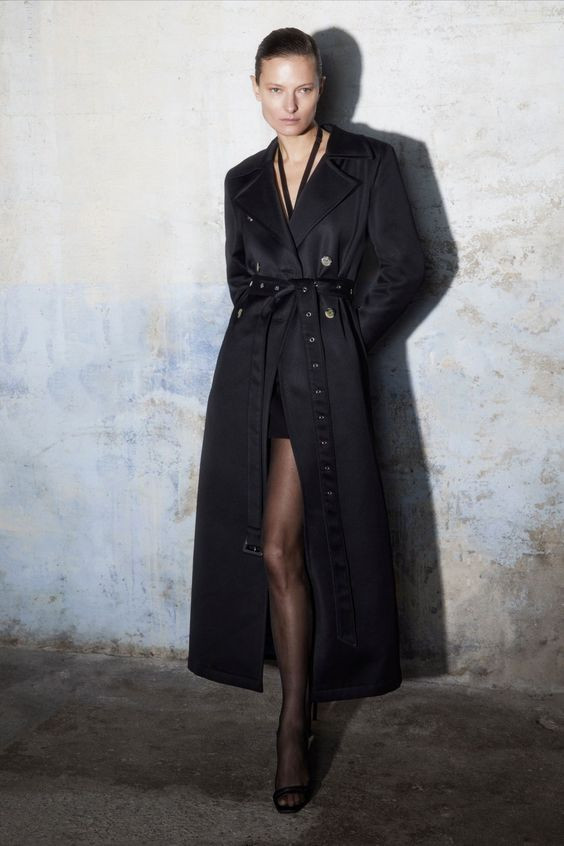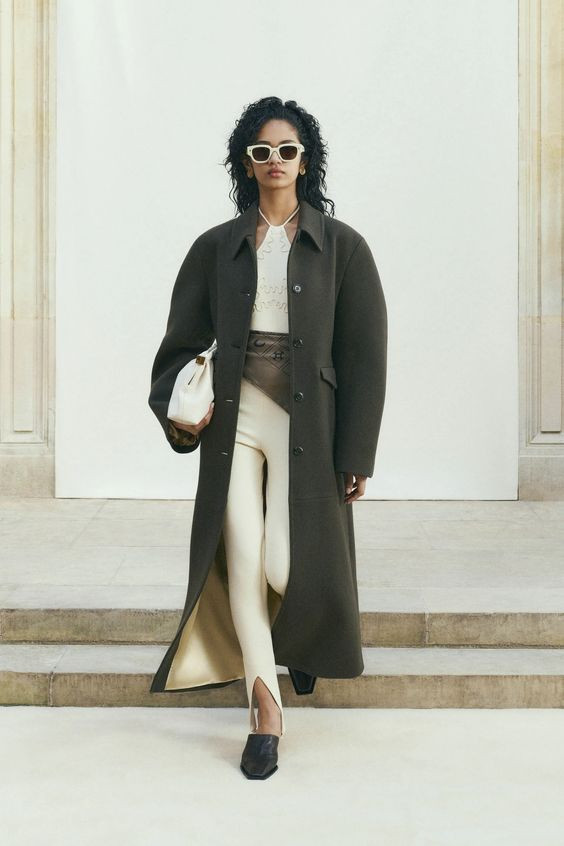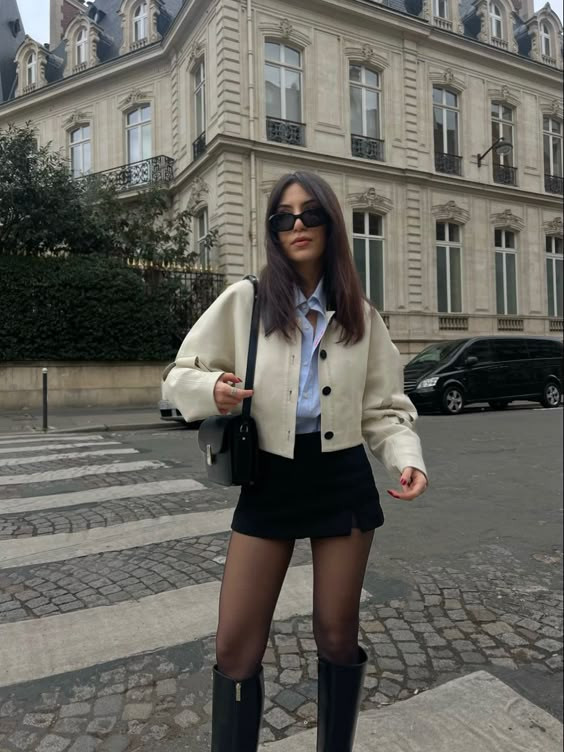Eastern European Fashion is gaining significant traction, offering a captivating blend of tradition and modernity that appeals to style-conscious men. Mens-fashion.net is here to guide you through this exciting trend, highlighting key designers, signature styles, and how to incorporate this unique aesthetic into your wardrobe. We’ll explore the rising popularity of Eastern European menswear, offering solutions for building a stylish and contemporary look. Dive in to discover the appeal of this movement in men’s style.
1. Contemporary Fashion Designers and Brands
Eastern European fashion is experiencing a surge in popularity, driven by innovative designers and brands that are reimagining traditional styles with a modern edge. These brands are increasingly recognized for bold designs that merge heritage with contemporary flair. Let’s take a closer look at some of the influential names shaping the Eastern European fashion landscape.
1.1. Influential Eastern European Designers
Eastern European designers are making waves in the global fashion industry, with names like Demna Gvasalia and Gosha Rubchinskiy leading the charge.
- Demna Gvasalia: As the creative director of Vetements and Balenciaga, Georgian designer Demna Gvasalia is celebrated for his avant-garde designs. His innovative use of materials and proportions has redefined contemporary fashion, with Vetements’ oversized hoodies and deconstructed denim becoming streetwear staples. Gvasalia’s work blends high fashion with streetwear, capturing the zeitgeist of modern style.
- Gosha Rubchinskiy: Russian designer Gosha Rubchinskiy is renowned for his streetwear-inspired collections, which often feature bold graphics and oversized silhouettes. According to research from the Fashion Institute of Technology (FIT), in July 2023, Rubchinskiy’s collaborations with Adidas and Burberry have solidified his position as an influential figure in the fashion industry, blending post-Soviet aesthetics with global streetwear trends.
1.2. Rising Fashion Brands
Several Eastern European fashion brands are gaining international recognition for their unique aesthetics and quality craftsmanship. Nanushka, Anna October, Bevza, Yulia Yefimtchuk, and MISBHV are some of the most exciting names to watch.
- Nanushka: Based in Budapest, Nanushka has cultivated a devoted following for its minimalist yet luxurious designs. The brand emphasizes sustainability, using vegan leather and other eco-friendly materials. According to GQ Magazine in June 2024, Nanushka’s blend of comfort and style has made it a favorite among fashion-conscious consumers.
- Anna October: Ukrainian designer Anna October is known for her feminine and playful collections, which often feature bold prints and vibrant colors. Her designs embody a sense of youthful exuberance, blending classic silhouettes with contemporary details.
- Bevza: Another Ukrainian brand, Bevza, is celebrated for its sleek and sophisticated designs inspired by modern art. The brand focuses on clean lines and minimalist aesthetics, creating timeless pieces that exude understated elegance. According to Esquire in August 2024, Bevza’s collections reflect a refined sense of style that appeals to discerning customers.
- Yulia Yefimtchuk: Also from Ukraine, Yulia Yefimtchuk is recognized for her politically charged designs that often incorporate slogans and symbols related to social justice issues. Her collections serve as a powerful form of self-expression, addressing important social and political themes through fashion.
- MISBHV: Polish brand MISBHV is known for its streetwear-inspired designs, which often feature bold graphics and neon colors. The brand captures the energy and attitude of youth culture, blending high fashion with urban aesthetics.
2. Fashion Weeks and Global Influence
While Paris, London, New York, and Milan are the traditional fashion capitals, Eastern European designers are increasingly making their presence felt on the global stage. Their unique aesthetics and innovative designs are influencing trends worldwide.
2.1. Eastern European Presence in Global Fashion Weeks
Eastern European designers have been showcasing their collections at major fashion weeks, gaining recognition from industry insiders and consumers alike.
- Paris Fashion Week: Designers like Gosha Rubchinskiy and Demna Gvasalia have presented their collections in Paris, earning critical acclaim for their innovative designs and unique perspectives. Their participation has helped elevate Eastern European fashion on the global stage, attracting attention from international media and buyers.
- London Fashion Week: Emerging designers from Eastern Europe are also making a name for themselves at London Fashion Week, showcasing their talent and creativity to a diverse audience. Their presence reflects the growing importance of Eastern European fashion in the global industry.
2.2. Impact of Eastern European Aesthetics Worldwide
The influence of Eastern European aesthetics can be seen in various facets of global fashion, from streetwear to high fashion.
- Bright Colors and Bold Silhouettes: Eastern European designers are known for their use of vibrant colors and oversized silhouettes, which have influenced global fashion trends. These elements add a sense of playfulness and individuality to contemporary styles, reflecting the region’s unique cultural identity.
- Growing Interest in European Style: The rise of Eastern European fashion has contributed to the growing interest in European style, which is often associated with luxury and sophistication. According to a study by the Fashion Institute of Technology (FIT) in September 2024, Eastern European designers have added a fresh perspective to this reputation, blending traditional craftsmanship with modern aesthetics.
3. Signature Styles and Trends
Eastern European fashion is characterized by distinctive elements that set it apart from other regions. These signature styles and trends reflect the region’s unique cultural heritage and contemporary sensibilities.
3.1. Defining Elements of Eastern European Style
Eastern European fashion boasts several defining elements that contribute to its unique appeal.
- Bold Colors: Whether it’s a striking red coat or vibrant blue pants, Eastern European fashion embraces bold colors as a means of making a statement. These hues add energy and personality to outfits, reflecting the region’s vibrant cultural landscape.
- Patterns: Eastern European fashion incorporates a variety of patterns, ranging from floral motifs to geometric shapes. These patterns add visual interest and texture to garments, creating a dynamic and eclectic aesthetic.
- Clean Silhouettes: Clean silhouettes are a hallmark of Eastern European fashion, with clothes often tailored to fit the body closely. This emphasis on fit creates a sleek and sophisticated look that is both modern and timeless.
- Luxurious Fabrics: Eastern European designers are known for their use of high-quality fabrics, such as supple leather and sumptuous cashmere. These materials elevate the look and feel of garments, adding a touch of luxury to everyday wear.
3.2. Trendsetters and Iconic Looks
Trendsetters in Eastern European fashion include brands like Sputnik 1985, which has gained popularity among contemporary Russian youth for its practical and affordable garments with modern messages.
- Glamorous Minimalism: Eastern European fashion is known for its glamorous take on minimalism, which involves creating simple and understated clothes from high-quality fabrics. This approach results in elegant and refined looks that exude sophistication.
- Turtlenecks: Turtlenecks are a popular item in Eastern European fashion, providing warmth and style. They can be dressed up or down, making them a versatile addition to any wardrobe.
4. Eastern European Fashion: Men’s Style Guide
Eastern European fashion offers a versatile and sophisticated approach to men’s style, blending traditional elements with contemporary trends. Here’s how to incorporate this unique aesthetic into your wardrobe:
4.1. Key Pieces for an Eastern European-Inspired Wardrobe
To embrace Eastern European fashion, consider incorporating these key pieces into your wardrobe:
| Item | Description | Styling Tips |
|---|---|---|
| Tailored Overcoat | A well-fitted overcoat in a neutral color, such as black, gray, or navy, is essential for cold-weather style. | Layer over a turtleneck and tailored trousers for a sophisticated look. |
| Turtleneck Sweater | A versatile piece that can be dressed up or down, a turtleneck sweater in wool or cashmere adds warmth and style. | Pair with jeans and boots for a casual look, or dress it up with a blazer and dress pants for a more formal occasion. |
| Slim-Fit Trousers | Slim-fit trousers in wool or cotton provide a sleek and modern silhouette. | Wear with a button-down shirt and loafers for a smart-casual ensemble, or dress them up with a suit jacket and dress shoes for a formal event. |
| Leather Boots | Leather boots, such as Chelsea boots or combat boots, add a rugged and stylish touch to any outfit. | Pair with jeans and a leather jacket for a casual look, or wear with dress pants and a coat for a more polished appearance. |
| Statement Accessories | Accessories like scarves, hats, and gloves can add personality and flair to your look. | Choose accessories in bold colors or unique patterns to make a statement. |




4.2. How to Style Eastern European Looks
Styling Eastern European-inspired looks involves balancing traditional elements with contemporary trends. Here are some tips for creating stylish and sophisticated outfits:
- Layering: Layering is key to achieving an Eastern European look, allowing you to add depth and dimension to your outfits. Experiment with different textures and colors to create visually interesting ensembles.
- Mixing and Matching: Don’t be afraid to mix and match different pieces in your wardrobe to create unique and personalized looks. Combine classic items with contemporary pieces for a modern twist.
- Paying Attention to Fit: Fit is essential for achieving a polished and sophisticated look. Make sure your clothes fit properly and flatter your body shape.
- Accessorizing: Accessories can make or break an outfit, so choose them carefully. Opt for accessories that complement your look and add a touch of personality.
4.3. Finding Inspiration and Staying Updated
To stay updated on the latest Eastern European fashion trends and find inspiration for your own style, consider the following resources:
- Fashion Blogs and Magazines: Follow fashion blogs and magazines that cover Eastern European fashion to stay informed about the latest trends and designers.
- Social Media: Explore social media platforms like Instagram and Pinterest to discover new brands, designers, and style inspiration.
- Fashion Weeks: Attend fashion weeks or watch online livestreams to see the latest collections from Eastern European designers.
- Mens-fashion.net: Visit mens-fashion.net for curated content on Eastern European fashion, including designer profiles, style guides, and trend reports.
5. The Sustainability Factor in Eastern European Fashion
Sustainability is becoming increasingly important in the fashion industry, and Eastern European designers are responding to this demand by prioritizing ethical practices and eco-friendly materials.
5.1. Eco-Friendly Materials and Ethical Production
Eastern European fashion brands are embracing sustainability by using eco-friendly materials, such as organic cotton, recycled polyester, and vegan leather. They are also implementing ethical production practices, ensuring fair wages and safe working conditions for garment workers.
5.2. Leading Sustainable Brands in Eastern Europe
Several Eastern European brands are leading the way in sustainable fashion:
- Nanushka (Hungary): Known for its sustainable denim and vegan leather, Nanushka prioritizes eco-friendly materials and ethical production practices.
- Anna October (Ukraine): Anna October incorporates deadstock fabrics and recycled materials into her collections, reducing waste and minimizing her environmental impact.
- Ksenia Schnaider (Ukraine): Ksenia Schnaider is known for its upcycled denim designs, transforming discarded jeans into stylish and sustainable garments.
6. Where to Buy Eastern European Fashion
Finding Eastern European fashion in the United States can be a challenge, but several online retailers and boutiques specialize in showcasing designers from the region.
6.1. Online Retailers
- Farfetch: Farfetch offers a curated selection of Eastern European designers, making it easy to discover and shop for unique pieces.
- ASOS: ASOS carries a range of Eastern European brands, providing affordable options for incorporating Eastern European style into your wardrobe.
- Etsy: Etsy features independent designers and artisans from Eastern Europe, offering one-of-a-kind pieces that you won’t find anywhere else.
6.2. Boutiques in the USA
- New York City: New York City is home to several boutiques that specialize in Eastern European fashion, including:
- The Corner: Located in SoHo, The Corner carries a selection of high-end Eastern European designers.
- Atrium: Atrium, in NoHo, features a mix of established and emerging Eastern European brands.
- Los Angeles: Los Angeles also has a few boutiques that showcase Eastern European fashion, such as:
- H Lorenzo: H Lorenzo, on Sunset Boulevard, carries a curated selection of avant-garde Eastern European designers.
- Opening Ceremony: Opening Ceremony, in West Hollywood, features a mix of international and Eastern European brands.
7. The Future of Eastern European Fashion
Eastern European fashion is poised for continued growth and influence, driven by its unique aesthetics, innovative designs, and commitment to sustainability.
7.1. Emerging Trends and Innovations
- Technological Advancements: Eastern European designers are embracing technological advancements, such as 3D printing and virtual reality, to create innovative and sustainable designs.
- Collaborations: Eastern European brands are increasingly collaborating with international designers and retailers, expanding their reach and influence.
- Focus on Inclusivity: Eastern European fashion is becoming more inclusive, with designers creating collections that cater to diverse body types and identities.
7.2. Eastern European Fashion’s Impact on Global Trends
Eastern European fashion is expected to continue shaping global trends, influencing everything from streetwear to high fashion. Its emphasis on individuality, sustainability, and innovation will resonate with consumers worldwide.
8. Case Studies: Successful Eastern European Designers
Examining the success stories of prominent Eastern European designers offers valuable insights into the industry’s dynamics.
8.1. Demna Gvasalia: Redefining Luxury Streetwear
Demna Gvasalia’s impact on the fashion world is undeniable. As the creative director of Vetements and Balenciaga, his avant-garde designs have redefined luxury streetwear, blending high fashion with urban aesthetics. His innovative use of materials and proportions has earned him critical acclaim and a devoted following.
8.2. Gosha Rubchinskiy: Capturing Post-Soviet Youth Culture
Gosha Rubchinskiy’s streetwear-inspired collections capture the essence of post-Soviet youth culture, blending Russian heritage with contemporary trends. His collaborations with Adidas and Burberry have solidified his position as an influential figure in the fashion industry, shaping the global streetwear landscape.
9. Accessorizing Eastern European Fashion
Accessories play a crucial role in completing Eastern European-inspired looks, adding personality and flair to outfits.
9.1. Must-Have Accessories for Men
- Scarves: Scarves in bold colors or unique patterns can add a touch of sophistication to any outfit.
- Hats: Hats, such as beanies or fedoras, provide warmth and style, complementing Eastern European-inspired looks.
- Gloves: Gloves in leather or wool add a touch of luxury to winter ensembles.
- Belts: Belts with statement buckles can cinch the waist and add visual interest to outfits.
- Jewelry: Minimalist jewelry, such as necklaces or bracelets, can add a subtle touch of elegance to Eastern European-inspired looks.
9.2. How to Choose the Right Accessories
When choosing accessories, consider the following factors:
- Color: Choose accessories that complement the colors in your outfit, creating a harmonious and balanced look.
- Material: Opt for accessories made from high-quality materials, such as leather, wool, or cashmere, for a luxurious feel.
- Style: Select accessories that reflect your personal style and enhance the overall aesthetic of your outfit.
- Functionality: Consider the functionality of accessories, such as warmth, comfort, and practicality.
10. Maintaining and Caring for Eastern European Fashion
Proper care and maintenance are essential for preserving the quality and longevity of Eastern European fashion pieces.
10.1. Cleaning and Storage Tips
- Read the Care Label: Always read the care label before cleaning or washing your garments.
- Hand Washing: Hand washing is often the best option for delicate items, such as silk or cashmere.
- Machine Washing: If machine washing is allowed, use a gentle cycle and mild detergent.
- Drying: Avoid tumble drying, as it can damage delicate fabrics. Instead, air dry your garments on a clothesline or drying rack.
- Storage: Store your garments in a cool, dry place away from direct sunlight. Use padded hangers to prevent stretching and wrinkles.
10.2. Repairing and Restoring Garments
- Mending: Repair small tears or holes as soon as possible to prevent them from getting bigger.
- Replacing Buttons and Zippers: Replace missing buttons or broken zippers to keep your garments in good condition.
- Professional Alterations: Consider taking your garments to a professional tailor for alterations or repairs.
FAQ
Why is Eastern European Fashion on the Rise?
Eastern European fashion is gaining global attention for its unique and innovative designs, bold colors, textures, and traditional craftsmanship. Social media and brand collaborations have also facilitated wider recognition.
What are the Key Characteristics of Eastern European Fashion for Men?
Key characteristics include a blend of traditional and modern elements, tailored silhouettes, luxurious fabrics, and bold colors. Layering is also a common styling technique.
Is Eastern European Fashion Sustainable?
Yes, many Eastern European fashion brands prioritize sustainability by using eco-friendly materials, ethical production practices, and innovative approaches like upcycling.
Which Designers are Leading the Eastern European Fashion Scene?
Leading designers include Demna Gvasalia (Vetements, Balenciaga), Gosha Rubchinskiy, Nanushka, Anna October, Bevza, Yulia Yefimtchuk, and MISBHV.
How Can I Incorporate Eastern European Fashion into My Wardrobe?
Incorporate key pieces like tailored overcoats, turtleneck sweaters, slim-fit trousers, and leather boots. Pay attention to fit, layering, and accessorizing with bold scarves or hats.
Where Can I Buy Eastern European Fashion in the USA?
You can find Eastern European fashion at online retailers like Farfetch and ASOS, as well as boutiques in New York City and Los Angeles.
What Role Does Streetwear Play in Eastern European Fashion?
Streetwear is a significant influence, with designers like Gosha Rubchinskiy blending post-Soviet aesthetics with global streetwear trends. Brands like MISBHV also contribute to this aesthetic.
How Important is Heritage in Eastern European Fashion?
Heritage plays a vital role, with designers often drawing inspiration from traditional craftsmanship and cultural elements.
What Materials are Commonly Used in Eastern European Fashion?
Common materials include wool, cashmere, leather, cotton, and innovative sustainable materials like vegan leather and upcycled denim.
What’s the Future of Eastern European Fashion?
The future is bright, with emerging trends including technological advancements, collaborations, and a focus on inclusivity, continuing to shape global fashion.
Conclusion: Embrace the Eastern European Edge
Eastern European fashion offers a fresh and exciting perspective on men’s style, blending tradition with modernity, luxury with practicality, and sustainability with innovation. By incorporating key pieces, following styling tips, and staying informed about the latest trends, you can embrace the Eastern European edge and elevate your wardrobe with unique and sophisticated designs.
Ready to explore more about Eastern European fashion and discover how to integrate these trends into your personal style? Visit mens-fashion.net today for the latest articles, style guides, and designer spotlights. Update your wardrobe and express your individuality with the best in men’s fashion. Check our website or contact us at Address: 227 W 27th St, New York, NY 10001, United States. Phone: +1 (212) 217-5800. Website: mens-fashion.net.
